Nokia Maps digitises streets to battle Google's threat
- Published
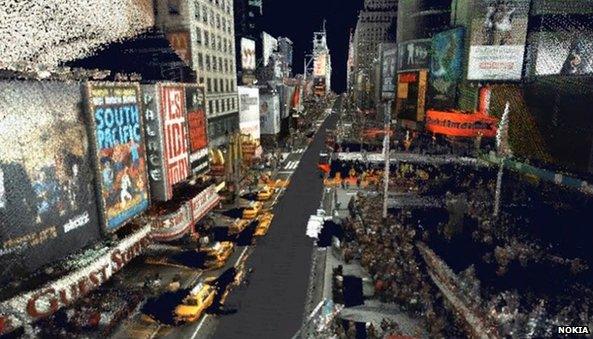
Nokia is combining data gathered by lasers and cameras to make interactive 3D images of cities
Nokia smells an opportunity. Maps have become one of the most closely-watched battlegrounds in tech after a user-backlash led Apple to apologise for the quality of its iOS6 Maps update.
The Finnish firm quickly capitalised by beating Google to the release of an app in Apple's iPhone and iPad store.
Giving away a product that cost millions of dollars to create to owners of a rival's products might seem like an odd business decision, but behind it lies a critical point.
If Nokia's 25-year-old mapping business is to survive the evolution from dedicated sat-nav systems to smart devices it needs to secure as much feedback data as it can.
That means attempting to woo smartphone and tablet users with a series of innovations.
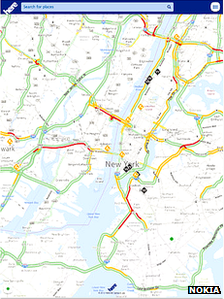
The Here app uses data sent from smartphones to mark traffic in red
Clear directions
You can already see a hint of the importance of feedback data in the colour codes Nokia uses to show which streets are suffering from busy traffic. It does this by taking anonymised GPS and movement readings from users' phones and other Nokia-powered sat-nav systems to work out road conditions.
Its upcoming Living Maps feature aims to take this a step further by colour-coding areas according to each user's leisure tastes.
"As people use their devices we can see for example where searches are done or where people are tweeting with their friends about a restaurant or a nightclub," Cliff Fox, Nokia's Chicago-based senior vice president of location content tells the BBC.
"So we are able to generate heat maps that show areas of activity that might be interesting.
"If you are out of town and visiting Chicago and don't know which good areas nightclubs might be in, you can bring up a heat map and see these kind of active areas."
The more devices use Nokia's location products the better the service should be.
The firm already powers the default map apps on Windows Phone handsets, Windows 8 computers and Amazon's Kindle tablets.
And beyond Apple's devices it also has its eye on the Android ecosystem with a toolset for third-party developers to tap into its data.
Drive-by sensors
Nokia is also investing in a fleet of True cars to help face off the challenge posed by Google's more famous Street View vehicles.
The True cars are fitted with a range of sensors including high-precision cameras and an inertial measurement unit which measures the slope of each road - a feature which could allow trucking companies to identify the least hilly routes in order to cut fuel costs.
But the critical feature is a rotating sensor called Lidar (light detection and ranging) which uses 64 lasers to capture 1.3 million points of digital information every second of each vehicle's journey.
"The lasers bounce off any reflective surface that allows us to capture lane markings [which use reflective paint], it shows us the exact location of road signs and it also allows us to capture the world in 3D," explains Mr Fox.
"That's the primary purpose... we are able to create at street-level a digital representation of the real world."
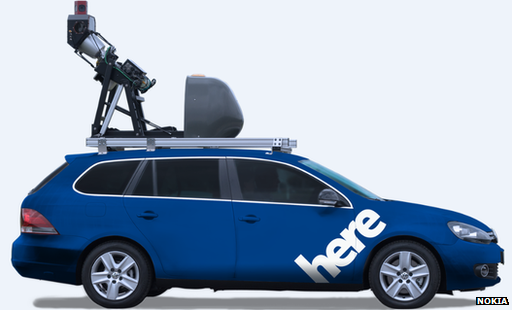
Nokia's True cars feature a fast-spinning device at their rear which sends out laser beams to the surrounding area
While Google's Street View offers panoramic photos, Nokia intends to offer a computer-created graphics-based version of the planet by combining Lidar-collected data with colour information gathered by panoramic cameras.
The advantage, Mr Fox suggests, is that Nokia can offer a highly-detailed depiction of the environment to pedestrians, but a less distracting version to motorists.
"It will also allow you to blank out part of the buildings or make some of the buildings opaque if your destination is behind several buildings," he adds.
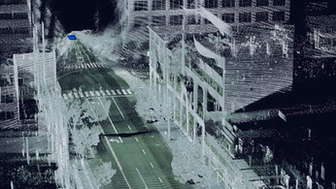
The Lidar data from a True car - represented in blue - is used to make graphics of buildings and street markings
The firm has been operating 45 True cars in the US and Western Europe - including the UK - for a year-and-a-half and plans to increase that number to 200 next year.
In addition it is in the process of taking over Earthmine - another company operating vehicles that create street-level graphical views - which will further boost its fleet.
But it's not all about eye-candy. Another use of its data is intended to make it unnecessary for Nokia map users to look at their screens at all.
Called Natural Guidance the facility aims to give the kind of voice-directions a knowledgeable friend would offer rather than what's currently provided by turn-by-turn systems.
Instead of saying, for example, "turn left in 100 metres" it will say turn after the church, or once you've crossed over the bridge, explains Mr Fox.
"Consumers have a lot of difficulty processing distances visually," he says.
"We believe this reduces stress."
Google's challenge
Tellingly when the product launches next year it will be one of the firm's partners who gets it before Nokia's own devices.
Because as upbeat as Mr Fox sounds, Nokia's mapping division needs to do all that it can turn a profit.
Historically it earned much of its revenue by licensing its Navteq maps to sat-nav device makers like Garmin. But sales of such standalone devices are plummeting and Nokia's location unit posted a 6% year-on-year drop in sales, external as a consequence.
The figure would have been much worse had the fall not been partially offset by a rise in demand from vehicle manufacturers. Nokia boasts that four out of five cars fitted with in-built sat-nav systems use its technology, but even this market is not safe.
"Google is clearly the the formidable competitor in the long-term for us," Mr Fox acknowledges.
"They are making enormous investments and they're trying to upgrade the quality of their data so that it could be viewed by car manufacturers as being navigation-grade maps."
The search giant is also known to be experimenting with Lidar technology and its mapping chief Brian McClendon recently told the BBC he had his own ambition to "get all of the pixels of the world in three dimensions and allow you to visit them".
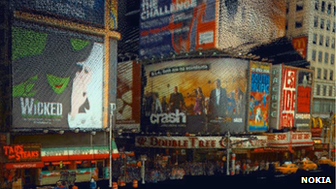
Information taken by panoramic cameras is combined with the Lidar data to create street-level coloured graphics
Industry watchers also expect Apple, TomTom and others will not give up without a fight.
"We don't know yet who the winner will be," says tech consultant Carolina Milanesi from Gartner.
"It's still early days and most consumers still think maps equals navigation. But consumers will decide they prefer one because it offers a better level of detail, number of relevant points of interest and 3D-view facilities.
"On smartphones most people thought maps meant Google, but they're now realising you can choose."
Over the coming years mapping looks set to be tech's equivalent of an arms race with huge amounts of money spent to come out on top.
But with the prospect of ever-more powerful phones, augmented reality glasses and even driverless cars, whoever has the most accurate and good-looking maps could find themselves well placed to reap huge rewards.
- Published14 November 2012
- Published28 September 2012
- Published10 September 2012